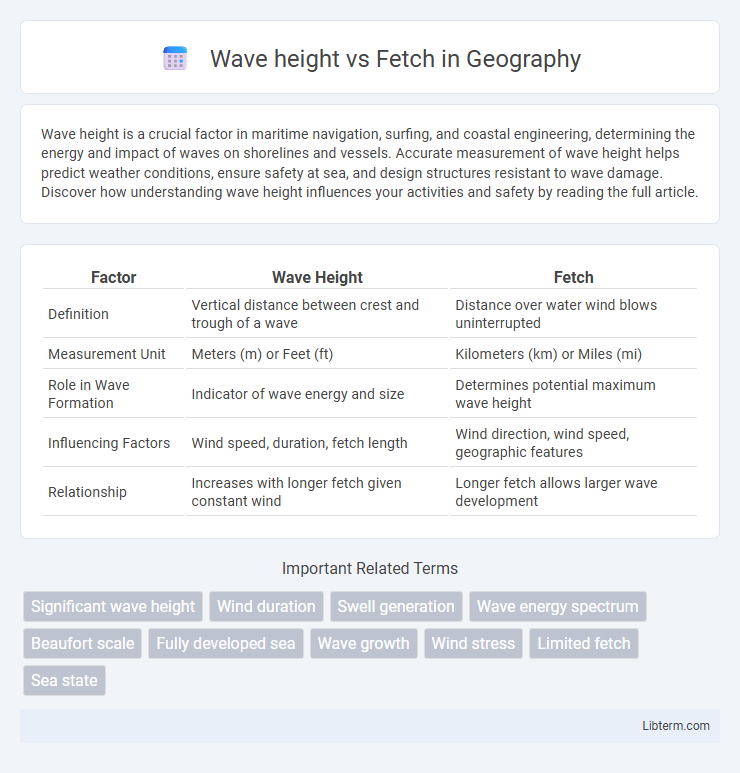Wave height is a crucial factor in maritime navigation, surfing, and coastal engineering, determining the energy and impact of waves on shorelines and vessels. Accurate measurement of wave height helps predict weather conditions, ensure safety at sea, and design structures resistant to wave damage. Discover how understanding wave height influences your activities and safety by reading the full article.
Table of Comparison
| Factor | Wave Height | Fetch |
|---|---|---|
| Definition | Vertical distance between crest and trough of a wave | Distance over water wind blows uninterrupted |
| Measurement Unit | Meters (m) or Feet (ft) | Kilometers (km) or Miles (mi) |
| Role in Wave Formation | Indicator of wave energy and size | Determines potential maximum wave height |
| Influencing Factors | Wind speed, duration, fetch length | Wind direction, wind speed, geographic features |
| Relationship | Increases with longer fetch given constant wind | Longer fetch allows larger wave development |
Understanding Wave Height: Key Concepts
Wave height is directly influenced by fetch, the uninterrupted distance over which wind blows across the water surface; longer fetch allows wind energy to transfer more effectively, producing larger waves. Key factors determining wave height include wind speed, duration, and the length of fetch, with fetch playing a critical role in wave development by providing the space necessary for wave growth. Understanding the relationship between wave height and fetch is essential for accurate coastal forecasting, marine navigation, and designing offshore structures.
What is Fetch in Oceanography?
Fetch in oceanography refers to the uninterrupted distance over water across which wind blows in a consistent direction, directly influencing wave development. The longer the fetch, the greater the wave height, as the wind transfers more energy to the water surface over that expanse. Wave height increases proportionally with both fetch length and wind speed, making fetch a critical factor in coastal and marine wave dynamics.
The Relationship Between Fetch and Wave Development
Wave height increases as fetch lengthens, allowing the wind more time and distance to transfer energy to the water surface. Longer fetch produces larger and more powerful waves due to sustained wind energy accumulation. The correlation between fetch and wave development is fundamental in coastal engineering and maritime navigation planning.
Factors Influencing Wave Height
Wave height is significantly influenced by fetch, which refers to the uninterrupted distance over water that wind blows in a consistent direction. Greater fetch allows wind energy to transfer more effectively to the water surface, resulting in larger wave heights. Other factors such as wind speed, wind duration, and water depth also play critical roles in determining the ultimate size and energy of waves.
How Fetch Length Impacts Wave Growth
Fetch length directly influences wave height by determining the distance over which wind energy transfers to the water surface; longer fetch allows waves to accumulate more energy, resulting in increased wave heights. Wave growth is limited by fetch length, wind speed, and duration, with fetch being a critical factor in the initial phase of wave development. Consequently, extensive fetch zones typically produce larger and more powerful waves due to sustained wind-wave interaction.
Real-World Examples of Fetch and Wave Height
Wave height is directly influenced by fetch, the uninterrupted distance over water that wind blows in a single direction. For example, the North Sea, with its extensive fetch area, regularly experiences significant wave heights exceeding 5 meters, while smaller lakes like Lake Erie have limited fetch and consequently lower wave heights typically under 2 meters. Coastal regions such as the western shores of Scotland also illustrate this relationship, where long fetch distances across the Atlantic result in powerful, high waves crucial for maritime navigation and coastal erosion studies.
Wind Speed and Duration: Effects on Fetch
Fetch length directly influences wave height by allowing wind energy to accumulate over a longer water surface, with stronger wind speeds generating larger waves faster. Extended wind duration amplifies this effect by sustaining energy transfer, resulting in higher wave heights across the fetch. Variations in wind speed and duration critically determine the maximum wave height achievable for a given fetch distance.
Measuring and Predicting Wave Height
Wave height is directly influenced by fetch, the uninterrupted distance over which wind blows across the water surface, impacting energy transfer and wave development. Accurate measurement of wave height utilizes tools such as wave buoys, radar altimeters, and LIDAR systems to capture real-time data, while predictive models integrate wind speed, fetch length, and duration to forecast wave conditions. Understanding the fetch-to-wave height relationship enables improved coastal engineering, navigation safety, and climate impact assessments.
Implications of Fetch for Coastal Erosion
Wave height directly correlates with fetch, the uninterrupted distance over water that wind travels, where longer fetches generate higher waves with increased energy and momentum. Higher wave energy from extensive fetches accelerates coastal erosion processes by exerting greater force on shorelines, leading to intensified sediment displacement and shoreline retreat. Understanding the fetch-wave height relationship is crucial for coastal management strategies aimed at mitigating erosion and protecting vulnerable coastal infrastructure.
Summary: Why Fetch Matters for Wave Height
Fetch is the uninterrupted distance over water that wind travels, directly influencing wave height by allowing waves to accumulate energy. Longer fetches result in larger waves due to increased wind energy transfer over the water surface, which promotes wave growth. Understanding fetch is essential for predicting wave size, crucial for coastal engineering, navigation safety, and marine activities.
Wave height Infographic

 libterm.com
libterm.com